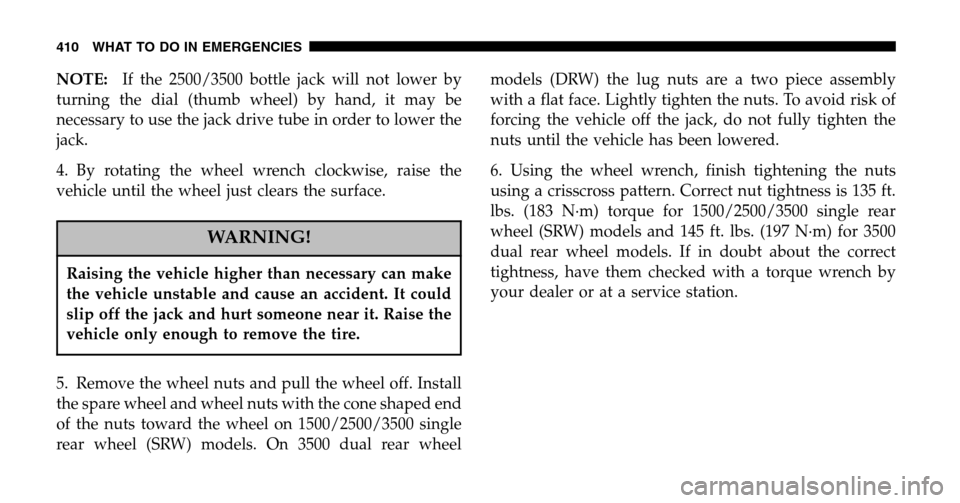Page 410 of 536

NOTE:If the 2500/3500 bottle jack will not lower by
turning the dial (thumb wheel) by hand, it may be
necessary to use the jack drive tube in order to lower the
jack.
4. By rotating the wheel wrench clockwise, raise the
vehicle until the wheel just clears the surface.
WARNING!
Raising the vehicle higher than necessary can make
the vehicle unstable and cause an accident. It could
slip off the jack and hurt someone near it. Raise the
vehicle only enough to remove the tire.
5. Remove the wheel nuts and pull the wheel off. Install
the spare wheel and wheel nuts with the cone shaped end
of the nuts toward the wheel on 1500/2500/3500 single
rear wheel (SRW) models. On 3500 dual rear wheel models (DRW) the lug nuts are a two piece assembly
with a flat face. Lightly tighten the nuts. To avoid risk of
forcing the vehicle off the jack, do not fully tighten the
nuts until the vehicle has been lowered.
6. Using the wheel wrench, finish tightening the nuts
using a crisscross pattern. Correct nut tightness is 135 ft.
lbs. (183 N·m) torque for 1500/2500/3500 single rear
wheel (SRW) models and 145 ft. lbs. (197 N·m) for 3500
dual rear wheel models. If in doubt about the correct
tightness, have them checked with a torque wrench by
your dealer or at a service station.
410 WHAT TO DO IN EMERGENCIES
Page 411 of 536

WARNING!
A loose tire or jack thrown forward in a collision or
hard stop could injure someone in the vehicle.
Always stow the jack parts and the extra tire and
wheel in the places provided.
7. Install wheel center cap and remove wheel blocks. Do
not install chrome or aluminum wheel center caps on the
spare wheel. This may result in cap damage.
8. Lower the jack to its fully closed position. If the bottle
jack will not lower by turning the dial (thumb wheel) by
hand, it may be necessary to use the jack drive tube in
order to lower the jack. Stow the replaced tire, jack, and
tools as previously described.
9. Adjust the tire pressure when possible. NOTE:
Do not oil wheel studs. For chrome wheels, do
not substitute with chrome plated wheel nuts.
Hub Caps/Wheel Covers
The hub caps must be removed before raising the vehicle
off the ground.
For 2500/3500 single rear wheel (SRW) models, use the
blade on the end of the lug wrench to pry the hub cap off.
Insert the blade end into the pryoff notch and carefully
pop off the hub cap with a back and forth motion.
On 3500 models with dual rear wheels (DRW), you must
first remove the hub caps. The jack handle driver has a
hook at one end that will fit in the pry off notch of the
rear hub caps. Position the hook and pull out on the
ratchet firmly. The hub cap should pop off. The wheel
skins can now be removed. For the front hub cap on 3500
models use the blade on the end of the lug wrench to pry
the caps off. The wheel skin can now be removed.
WHAT TO DO IN EMERGENCIES 411
6
Page 443 of 536

Front Prop Shaft Lubrication — 2500/3500 (4X4)
Models
Lubricate the front driveshaft grease fitting at each oil
change listed in the appropriate Maintenance Schedule
for your vehicle (Schedule “A” and “B”). Use Mopar �
type MS-6560 (lithium based grease), or equivalent.
Body Lubrication
Locks and all body pivot points, including such items as
seat tracks, doors, tailgate and hood hinges, should be
lubricated periodically to assure quiet, easy operation
and to protect against rust and wear. Prior to the appli-
cation of any lubricant, the parts concerned should be
wiped clean to remove dust and grit; after lubricating
excess oil and grease should be removed. Particular
attention should also be given to hood latching compo-
nents to insure proper function. When performing other
underhood services, the hood latch, release mechanism
and safety catch should be cleaned and lubricated.
The external lock cylinders should be lubricated twice a
year, preferably in the fall and spring. Apply a small
amount of a high quality lubricant such as Mopar �Lock
Cylinder Lubricant directly into the lock cylinder.
Front Driveshaft Grease Fitting
MAINTAINING YOUR VEHICLE 443
7
Page 466 of 536
INTEGRATED POWER MODULE
An integrated Power Module is located in the engine
compartment near the battery. This center contains car-
tridge fuses and mini fuses. A description of each fuse
and component may be stamped on the inside cover otherwise the cavity number of each fuse is stamped on
the inside cover that corresponds to the following chart.
Cavity Cartridge
Fuse Mini
Fuse Description
1 20 Amp Yellow Power Outlet Console
2 20 Amp Yellow CCN Door Locks/
BTSI
3 20 Amp Yellow Spare
4 20 Amp Yellow Spare
5 20 Amp Yellow Power Sunroof
6 10 Amp Red OCM/VIST Fan/
Wastegate
7 15 Amp Blue Reverse Lockout Sole-
noid Battery (SRT-10
Only)
Integrated Power Module Location
466 MAINTAINING YOUR VEHICLE
Page 469 of 536

Cavity Cartridge Fuse Mini
Fuse Description
38 20 Amp Yellow Power Outlet IP
39 10 Amp Red Sunroof/Seatbelt Ten-
sioner
40 20 Amp Yellow Cigar Lighter
41 25 Amp Natural Spare
42 30 Amp Pink Diesel PCM (Diesel
Only)
1. Disconnect the battery negative (-) cable before remov-
ing the cover.
2. Use specified fuses only.
3. Always properly reinstall the cover.VEHICLE STORAGE
If you are storing your vehicle for more than 21 days, we
recommend that you take the following steps to mini-
mize the drain on your vehicle’s battery:
•Disconnect the Ignition-Off Draw fuse (I.O.D.) fuse
located in the Integrated Power Module, located in the
engine compartment. The I.O.D. cavity includes a
snap-in retainer that allows the fuse to be discon-
nected, without removing it from the fuse block.
•The electronic shift transfer case should be placed in
the 4HI mode and kept in this position to minimize the
battery drain.
•As an alternative to the above steps you may, discon-
nect the negative cables from both batteries.
NOTE: When reinstalling the IOD fuse, the gages in the
Instrument Cluster will do a full sweep, when the
ignition key is cycled to RUN. This is a normal condition.
MAINTAINING YOUR VEHICLE 469
7
Page 473 of 536
5. Unlock and pull connector straight from the base of
the headlight halogen bulb.
6. Twist connector on turn signal/park light bulb
1�4turn
and remove connector and bulb from housing. 7. Remove housing from vehicle with headlight halogen
bulb in housing.
8. Twist the headlight halogen bulb
1�4turn and remove
headlight bulb from the housing.
9. Replace headlight or turn signal bulb. Do not touch
the headlight halogen bulb.
10. Reverse procedure for installation of bulbs and hous-
ing.
Bulb Removal
MAINTAINING YOUR VEHICLE 473
7
Page 475 of 536
3. Push the red lock slide in on the connector and remove
the housing from the vehicle.
4. Remove the four (4) screws from the bulb strip in the
housing. 5. Pull the appropriate bulb straight from the bulb strip.
•Top Bulb: Park/Turn/Hazard
•Center Bulb: Stop/Park/Sidemarker
•Bottom Bulb: Backup Lights
6. Reverse procedure for installation of bulbs and hous-
ing.
MAINTAINING YOUR VEHICLE 475
7
Page 479 of 536
Tailgate ID Lights (Dual Rear Wheels) — If
Equipped
1. Remove the two screws and housing and access the
bulb sockets from the rear. 2. Turn socket
1�4turn counterclockwise to access the
bulb.
MAINTAINING YOUR VEHICLE 479
7